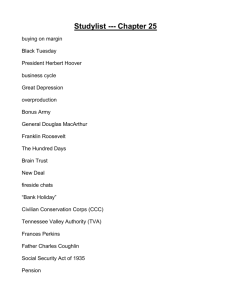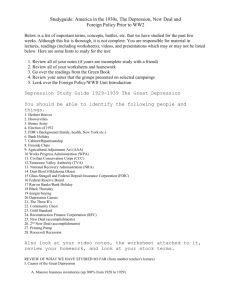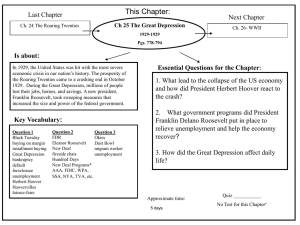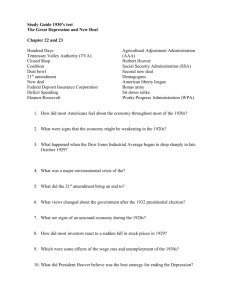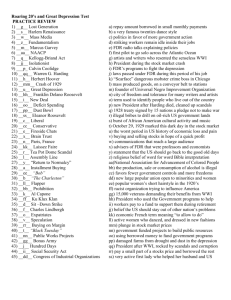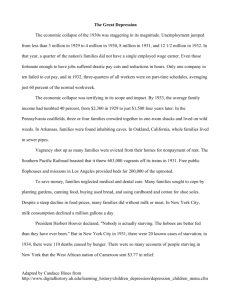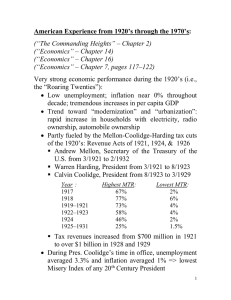JB APUSH Unit VIIIB
advertisement
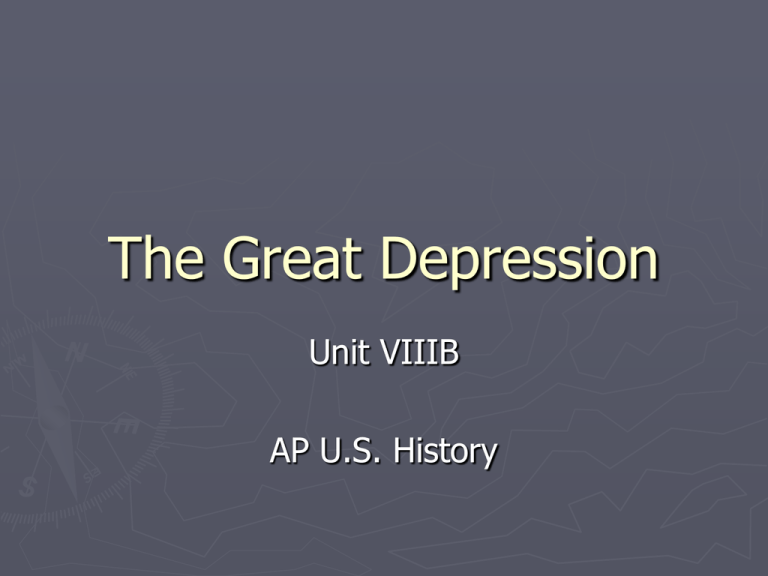
The Great Depression Unit VIIIB AP U.S. History Fundamental Question ► To what extent did the Great Depression maintain continuity and fostered change in America’s political and economical structures? Causes of the Great Depression ► Political Policies “The business of America is business.” Mellon’s Tax Bills Fordney-McCumber Tariff Dawes Plan and Post-WWI lending ► Financial Practices Installment plans “Buying on Margin” Crash of 1929 ► Economic Situations Agricultural overproduction and low prices Welfare capitalism and consumer confidence ► Socioeconomic Conditions Top 1% owned 35% of nation’s wealth Bottom 20% owned 4% of nation’s wealth The Stock Market and the Crash of 1929 ► Background Speculation “Buying on Margin” ► The Crash of 1929 381.17 (9/3/29) Concern over high stock prices led to massive sell-off Thursday, October 24 ► 299.50 Monday, October 28 ► 260.64 Tuesday, October 29 ► 230.07 41.22 (7/8/32) Herbert Hoover (R) (1829-1933) ► ► ► ► ► “Given the chance to go forward with the policies of the last eight years, we shall soon with the help of God, be in sight of the day when poverty will be banished from this nation.” - Inauguration, March 4, 1929 “There is no cause to worry. The high tide of prosperity will continue.” Sec. Of Treasury Andrew Mellon, Sept. 1929 “While the crash only took place six months ago, I am convinced we have now passed the worst and with continued unity of effort we shall rapidly recover.” Pres. Hoover, May 1, 1930 “The worst is over without a doubt.” Sec. Of Labor James Davis, June 29, 1930 Hoover’s Economic Philosophy Promote voluntarism, restraint, and self-reliance “If we shall be called upon to endure more of this period, we must gird ourselves for even greater effort… The question is whether that history shall be written in terms of individual responsibility, and the capacity of the Nation for voluntary cooperative action, or whether it shall be written in terms of futile attempt to cure poverty by the enactment of law, instead of the maintained and protected initiative of our people.” April 27, 1931 Hawley-Smoot Tariff (1930) ► Federal Farm Board ► Reconstruction Finance Corporation (RFC) ► Depression by Numbers ► Dow Jones Industrial Average 1929: 381.17 1932: 41.22 The average of stock prices dropped over 90% ► ► 1929: 659 banks ($200,000,000) 1930: 1,300 banks (853,000,000) 1931: 2,294 banks ($1,700,000,000) ► Price Indices Unemployment 1929: 3.2% 1933: 24.9% Unemployment rates higher in specific regions, among different groups ► ► ► 1929: $103.6B 1933: $56.4B Manufacturing wages down 60% Farmers’ income declined 55% ► Industrial production Down 26% in 1930; 51% by 1932 ► Investments $10B in 1929; $1B in 1932 ► Fertility Rates 1928: 93.8 1933: 76.3 Toledo, OH: 90% GDP Income National income fell $80B to $50B Salaries declined 40% Consumer prices feel 25% Wholesale prices fell 32% ► Bank Failures ► Suicide Rates 1920-1928: 12.1 1929: 18.1 1930-1940: 15.4 Hoovervilles Displaced Americans set up shanty towns Came to be known as “Hoovervilles” Public Reaction to Depression ► Bonus March WWI veterans marched on D.C. demanding early payments of pensions Federal troops sent in to break up Hoovervilles Depression through Pictures The Dust Bowl (1930-1936) ► Causes Overgrazing Improper farming techniques Increased cultivation Drought in 1934 ► Effects Dust storms Black Sunday April 14, 1935 ► 300 million tons of topsoil blown across southern Plains region Migration west ► ► “Okies” Mexican Repatriation Dust Turns Day Into Night Election of 1932 ► Franklin Delano Roosevelt (FDR) (D) Campaign promise of a “new deal” and help for the “forgotten man” New Deal Coalition ► ► Herbert Hoover (R) A Realignment Election End of the Republican dominance of the Fourth Party System Begin of the Democrat dominance of the Fifth Party System Fifth Party System (1932-1968) ► Democrats New Deal Coalition ► ► ► ► ► ► ► ► ► ► Catholics Jews Blacks Progressive Intellectuals Urban Machines Populist Farmers White Southerners Labor Unions Low-Income Immigrants Philosophy Social liberalism/social democracy ► Social justice ► Keynesian economics ► Dominated Congress and American public for the next 36 years ► Republicans Pro-business Economic conservatives Social conservatives Northeast, parts of the Midwest Franklin D. Roosevelt (D) (1933-1945) ► Great Depression ► New Deal ► Good Neighbor Policy ► Arsenal of Democracy ► Pearl Harbor ► World War II FDR’s Message of Hope ► ► ► FDR had no specific plan for the Depression Calming the nation “… the only thing we have to fear is fear itself.” Fireside chats The Three R’s Relief Recovery Reform ► Brain Trust Capable advisers ordered to experiment, be pragmatic “Do something.” The First New Deal (1933-1934) FDR’s First Hundred Days “Alphabet Soup” ► ► Emergency Banking Act (Bank Holiday) Federal Emergency Relief Administration (FERA) Civil Works Administration (CWA) ► ► ► Civilian Conservation Corps (CCC) Agricultural Adjustment Administration (AAA) National Industrial Recovery Act (NIRA) Public Works Administration (PWA) National Recovery Administration (NRA) ► Tennessee Valley Authority (TVA) First New Deal (1933-1934) ► Banking Act of 1933 Glass-Steagall Act Federal Deposit Insurance Corporation (FDIC) ► ► ► ► ► ► Gold Reserve Act Farm Credit Administration (FCA) Securities and Exchange Commission (SEC) National Labor Relations Board (NLRB) Federal Housing Administration (FHA) Indian Reorganization Act 21st Amendment (1933) ► 18th Amendment repealed Only Amendment to be ratified by state conventions ► End of Prohibition ► Reasons Development of black market for alcohol Increased violence due to rise in organized crime Loss of revenue, industry, and employment Speakeasies replaced saloons The Second New Deal (1935-1938) ► ► Resettlement Administration (RA) Works Progress Administration (WPA) National Youth Administration (NYA) Federal One ► Federal Writers Project ► Federal Theatre Project ► Federal Music Project ► Federal Art Project ► Historical Records Survey ► ► ► ► Rural Electrification Administration (REA) Social Security Act (1935) Wagner Act (1935) Fair Labor Standards Act (1938) Federal government used posters, songs, advertisements, literature to promote and support FDR’s New Deal programs among the American public Federal One New Deal Opposition ► “New Deal is doing too much.” Republicans and economic/fiscal conservatives “Boondoggles” ► “New Deal is not doing enough.” Father Charles Coughlin Senator Huey Long – “Kingfish” ► Share the Wealth $5000 for every family, $2000 annually Heavily tax wealthy Election of 1936 ► Franklin D. Roosevelt (D) ► Alfred Landon (R) FDR and Court Packing ► Supreme Court reversed several New Deal programs Schechter Poultry Corp. v. United States (1935) ► NIRA unconstitutional United States v. Butler (1936) ► AAA ► unconstitutional Justice Reorganization Bill Appoint new justices for every justice over 70 ►6 ► additional justices Subsequent Supreme Court rulings in favor of New Deal Social Security Act Wagner Act New Deal and Labor ► American Federation of Labor (AFL) Strengthened and increased membership ► Congress of Industrial Organizations (CIO) Organize unskilled laborers in major industries Industrial unionism ► United (UAW) Automobile Workers Used sit-down strikes to earn recognition Escapism Great Depression in Arts and Entertainment ► Literature John Steinbeck ► ► ► The Grapes of Wrath Of Mice and Men Photography Dorothea Lange ► Music Brother, Can You Spare a Dime? Woody Guthrie ► Radio Comedies Soap operas ► Movies The Wizard of Oz Shirley Temple Snow White and the Seven Dwarves Marx Brothers Escapism Great Depression in Sports and Recreation ► Sports WPA ► Athletic facilities ► Athletic educational programs Innovation, consolidation, and sacrifice of professional and college sports ► College bowl games ► NFL playoffs ► Recreation Games and Monopoly Gambling Rodeos Dance halls and jazz End of the New Deal ► Roosevelt Recession (1937-1938) Cutback in deficit spending and elimination of some New Deal programs ► Hatch Act (1939) ► International Concerns Totalitarian governments spawned defensive preparations
